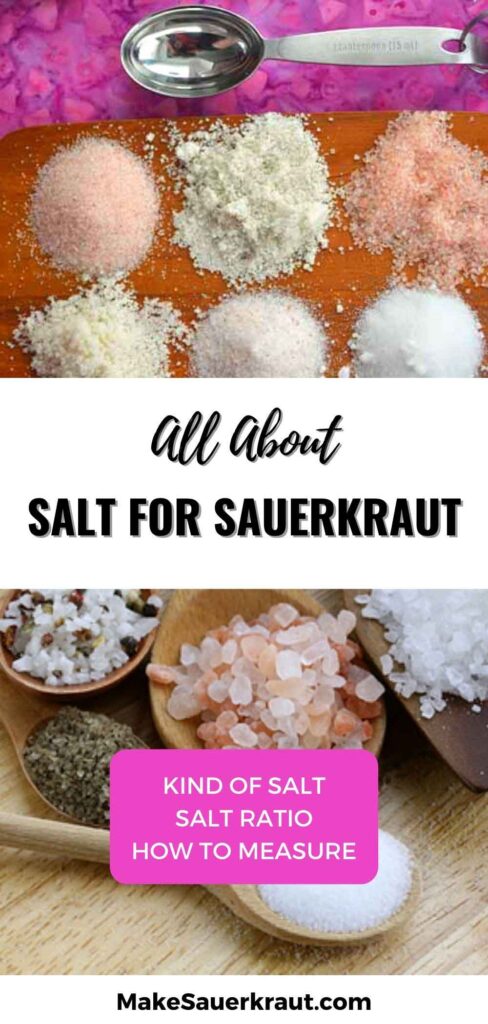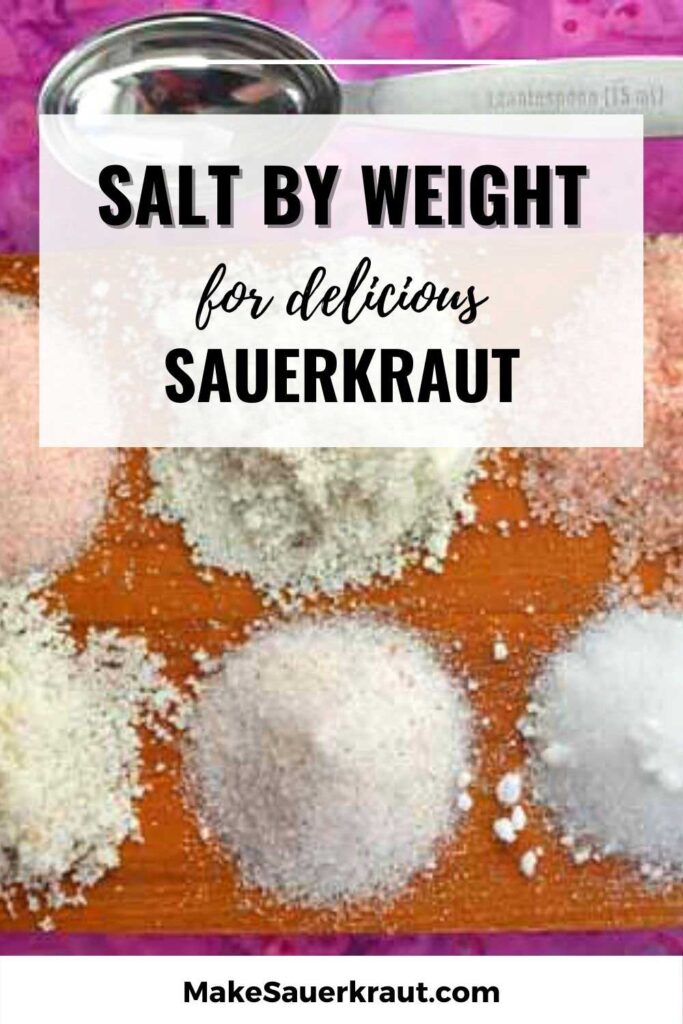How much salt – and which salt – should you use to make delicious, perfectly fermented sauerkraut batch after batch? Salt by taste? Salt by measuring? Salt by weight?
Some good questions.
In all my sauerkraut recipes, I have you weigh out 1 ¾ pound (800 grams) of cabbage and vegetables, add 1 tablespoon of salt, mix and then pack into a quart (liter) jar. Works darn good.
However, I started getting questions on how to make sauerkraut in a jar other than the standard American quart canning jar, how to calculate the right amount of salt without using a measuring spoon, or how to reduce the amount of salt used. And, I also was alerted to a variance in the size of tablespoons.
I did not know that measuring spoons are not standard throughout the world. In Australia, a tablespoon is 20 ml; Great Britain, 17.7 ml: North America and elsewhere, 14.7 ml. That’s a 25% difference in tablespoons between the U.S. and Australia.
Enter that scale I am so adamant about owning if you want to successfully ferment sauerkraut.
Weigh Your Cabbage and Vegetables to Guarantee a Perfect Ferment
And a digital scale at that.
A Scale for Salt by Weight or a Measuring Spoon for Salt by Volume?
I had been ignoring a few fermenters out there who emphasize the need to determine your salt by weight due to a variation in the weight of salt from one type of salt to another. I had steered away from weighing my salt because I didn’t want to complicate matters for first-time fermenters and felt “If it ain’t broke, then don’t fix it!” Besides, what does it mean to “weigh” your salt?
Before we go further, don’t freak out and feel you have to start weighing your salt. What I share here is just an option. There is a greater degree of flexibility to the fermentation world than I care to admit. However, I also know that the more variables you eliminate the greater your chances for success, batch after batch. And keep in mind, I’ve successfully fermented sauerkraut for close to 15 years using a measuring spoon.
OK, time to head to my kitchen and find out if there is a difference in weight with the various types of salt.
I pulled out my prized EasyWeigh KD8000 kitchen scale and scavenged around in my cupboards to find neglected salts since I now only use Himalayan Pink Salt not only for fermenting but for all my salt needs. Here are the salts I found:
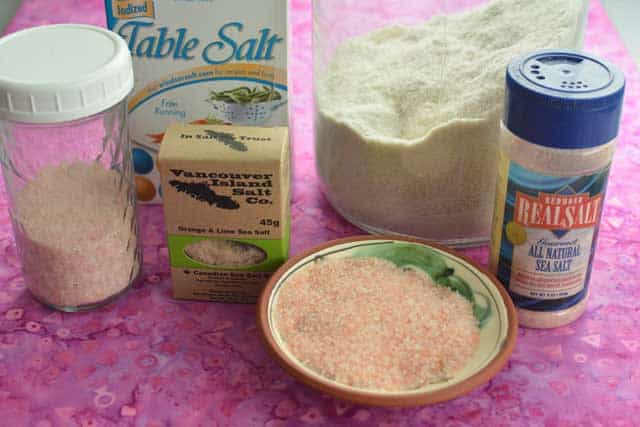
- A box of that nasty, pure-white stuff complete with anti-caking agents and iodine.
- A stash of Celtic gray salt.
- A local Vancouver Island sea salt
- Himalayan Pink Salt, fine grain.
- Some large-grained Himalayan Pink salt.
- A small jar of Redmond Real Salt.
I pulled out my measuring spoons and using a knife to level the spoon, measured out 1 tablespoon of each salt.
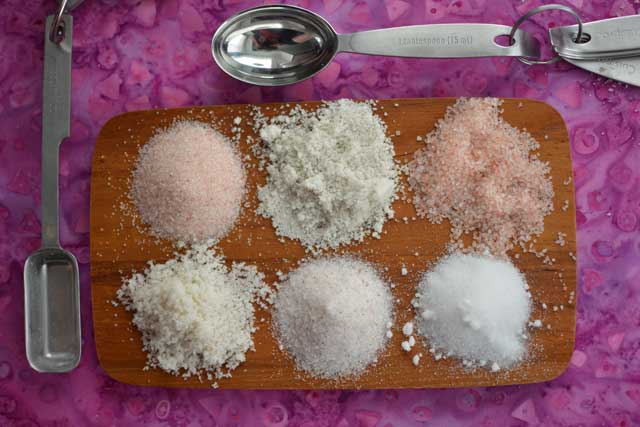
What did I discover?
Here’s a table with what one tablespoon of each salt weighed in grams.
| Himalayan Pink Salt, Fine Grain | Celtic Gray Salt | Himalayan Pink Salt, Coarse Grain | Redmond Real Salt | Vancouver Island Sea Salt | Iodized Table Salt |
| 13 g | 10 g | 14 g | 12 g | 9 g | 12 g |
One tablespoon of the two salts that are evaporated seawater with no further processing weighed in at only 9-10 grams of salt. Now, I know why I often had trouble getting consistent results with my Celtic Gray Sea Salt. I would have been using way too little salt.
What does all this mean?
- Measuring spoons can be inaccurate and vary from one spoon to the next.
I have two sets and have always thought one looked a bit larger than the other. It is! - Different salts do weigh different amounts.
This is due to variance in grind size, density, and moisture content. - I need to start thinking about the advantage of weighing my salt.
Weighing salt will allow you to adjust your batches of sauerkraut to your taste preferences and fermentation conditions. In real warm weather, you may want to use 2.5%; in cooler weather 1.5%. If you’re finding your sauerkraut too salty, adjust down to 1.5%.
Why is It Important that You Use the Right Amount of Salt?
Salt is the workhorse in your ferment. The right amount of salt is critical for creating the environment for mighty-microbes to ferment that sweet cabbage of yours into tangy sauerkraut.
- The right amount of salt encourages the right bacteria – lactic-acid bacteria – to thrive and grow, giving them a competitive advantage over the hostile bacteria.
- Too little salt favors harmful bacteria that can not only turn your sauerkraut to mush but may cause mold or yeast to grow.
- Too much salt and the lactic-acid bacteria will not multiply. You end up with cabbage pickled in salt, not fermented sauerkraut.
- Too much salt and unwanted salt-tolerant bacteria and yeasts will grow. Not what you want.
What is the Right Amount of Salt?
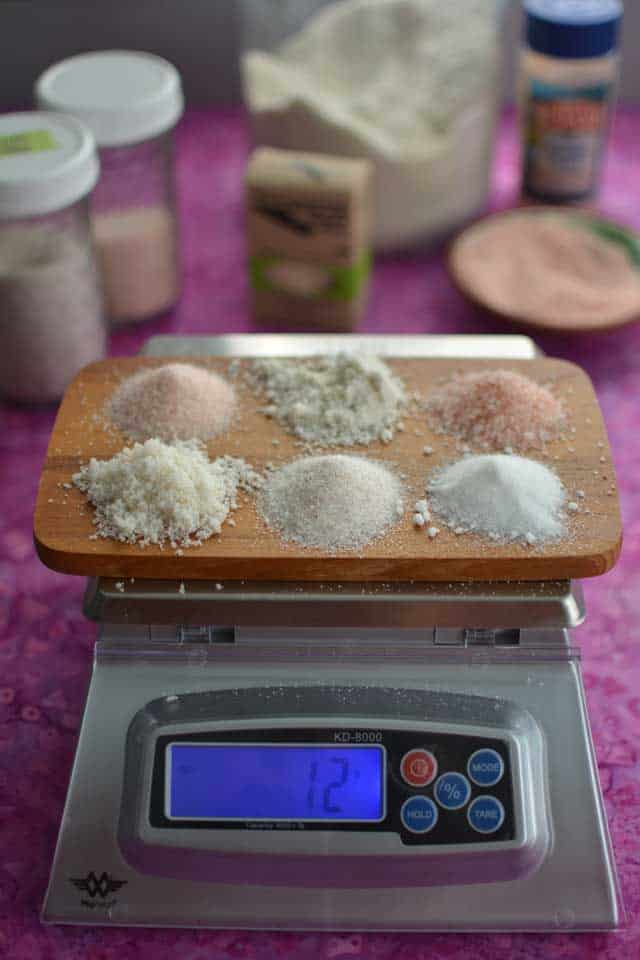
The fermentation of sauerkraut is done through a self-brining process. Salt is evenly mixed with finely sliced cabbage to allow moisture to be drawn out of the cells to form a brine in which safe fermentation can proceed.
This is opposed brined fermentation where whole or roughly vegetables – cucumbers, carrots, garlic, etc. – are packed into a jar or crock and a 2% – usually – brine is mixed and poured over them.
Calculating Salinity Percentage
For sauerkraut, the goal is to create a salinity ratio of 1.5% to 2.5% to ensure safe and flavorful fermentation. These numbers come from fellow fermenters along with studies on what salinity range is best for fermentation of sauerkraut.
Three ways to determine the right amount of salt:
- Salt by Taste.
When calculating salinity by taste, you mix salt with cabbage, take a pinch and taste. If it tastes somewhat salty, but not offensively so, you’re good.
This is how I first made sauerkraut but was unable to achieve consistent results. I’ve since learned that the health of our adrenal glands may play a factor on how salty food may taste at any given moment. Our adrenals are nourished by the minerals in salt. If our adrenal health is compromised we will crave salty foods – for the minerals necessary to heal our adrenals – and will need to add more salt than usual to a dish to get it to taste salty. Not exactly a foolproof way to ferment sauerkraut. - Salt by Volume.
When calculating salinity by volume, you use the volume of a measuring spoon to calculate the amount of salt. Hence, the one tablespoon of salt called for in my recipes.
That 15 ml measuring tablespoon most of us use? That translates to approximately 2% of salt for the 1 ¾ pounds (800 grams) cabbage I have you weigh out.
The drawback of this method is that not all measuring spoons are alike and not all salts measure the same. - Salt by Weight.
When calculating salinity by weight, you set a digital scale to grams and first weigh your cabbage mixture, calculate 1.5-2.5% grams of salt for that weight. Step-by-step help in the box below.
This is the most reliable and consistent way to determine the right amount of salt to use in any given batch of sauerkraut and allows you to effortlessly make any sized batch of sauerkraut.
How do professional bakers make their chewy, flavorful bread? You guessed it. With a scale and using flour and water percentages!
If you do not have a scale, check my supplies for recommended brands:
Fermenting Supplies for Sauerkraut & Vegetables [The Classics, The Latest, The Greatest]
Choosing Your Salt
Refined Salts
Refined salt is a crystalline mineral made of two elements off the periodic table: sodium and chloride. Table salt, sea salt, iodized salt, kosher salt and pickling salt are all examples of processed or refined salts. Some contain additives – iodine, sugar or anti-caking agents such as calcium silicate.
Refined salts are 97-99% sodium chloride.
Mineral-Rich Salts
Mineral-rich salts contain mainly sodium and chloride but also numerous trace minerals that give the salt a sweeter taste and provide additional nutrients for the bacteria that ferment your sauerkraut.
Mineral-rich salts (Himalayan Pink and Redmond Real Salt) are 97% sodium chloride.
Many people and companies now ferment with mineral-rich salts and use the recommended 1.5-2.5% salinity.
An overview of your salt options – in order from best to worst – and how they may impact the salinity and saltiness of your finished sauerkraut.
- Himalayan Pink Salt – My Favorite Salt.
The prized salt of fermenters and currently the only one I use for fermentation.
Less salty taste to sauerkraut due to a slightly lower percentage of sodium chloride in addition to a range of trace minerals. - Redmond Real Salt – Also a Good One.
Another popular salt for fermenting.
Less salty taste to sauerkraut due to a lower percentage of sodium chloride in addition to a range of trace minerals. - Pickling Salt – Works Fine.
A more affordable option than Himalayan Pink Salt or Redmond Real Salt.
Sauerkraut might taste extra salty due to minerals removed by processing; only sodium chloride. - Industrial Sea Salt – Check the Label.
Check the label to make sure it does not contain additives.
Sauerkraut might taste extra salty taste due to minerals removed by processing; only sodium chloride. - Grey or Celtic Sea Salt – No Longer Recommended.
I used this salt for a while but often ended up with mushy, moldy sauerkraut due to moisture content. In addition, it feels light and airy. So when using a measuring spoon, you’re getting less sodium chloride than you realize.
I no longer recommend it due to due to higher levels of pollution found in our waters today. - Kosher Salt – Not Ideal.
A larger grain that may take longer to dissolve during the brining process.
Sauerkraut might taste extra salty taste; stripped of naturally occurring minerals. - Table Salt or Iodized Sea Salt – Not Recommended.
A highly refined salt with trace minerals removed.
Anti-caking agents and iodine added that may interfere with the fermentation process.
For a complete discussion on salts, see:
What is the Best Salt to Use When Making Fermented Sauerkraut?
Calculating Salt by Weight When Making Sauerkraut
Now, how to calculate how much salt to use by weighing both your cabbage mixture and your salt.
- Set scale to grams.
- Place bowl on scale and note tare or zero out scale.
- Add your shredded cabbage and prepped vegetables and note weight.
- If necessary, subtract tare.
- Multiply actual weight (without tare) of cabbage mixture by 2% (.02), the recommended salinity for sauerkraut.
For example, the weight of your shredded cabbage and vegetables is 800 grams.
800 x .02 = 16.00
Add 16 grams of salt.
NOTE: The recommended salinity for sauerkraut actually ranges from 1.5-2.5%. I use 2.0% because the math is easy; feel free to use 1.5% (x .o15) or 2.5% (x .025) or play around with what works best for the salt you use and your fermentation environment. - Sprinkle salt into bowl until scale reads 816 grams. This is the weight of your cabbage, seasoning vegetables, AND the salt.
Now a simple way to get super-consistent results… batch after batch. And, if you’ve been unhappy with the “saltiness” of your sauerkraut try a different salt. You might just be pleasantly surprised.
Here’s Robb Wolf, author of [amaozn link =”0982565844″ “The Paleo Solution”], making a batch of sauerkraut with his daughter.
Now, time to make some sauerkraut calculating salt by weight. Grab your scale, pick a recipe to please your palate and start slicing:
Sauerkraut Recipes to Please Any Palate
SureFire Sauerkraut Recipe Collection
Last update on 2024-04-25 / Affiliate links / Images from Amazon Product Advertising API

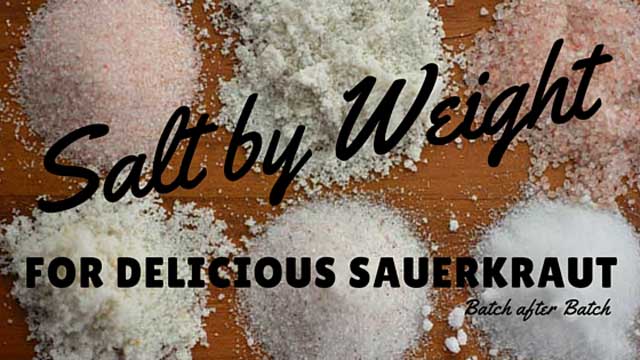

 This post may contain affiliate links which won’t change your price but will share some commission.
This post may contain affiliate links which won’t change your price but will share some commission.